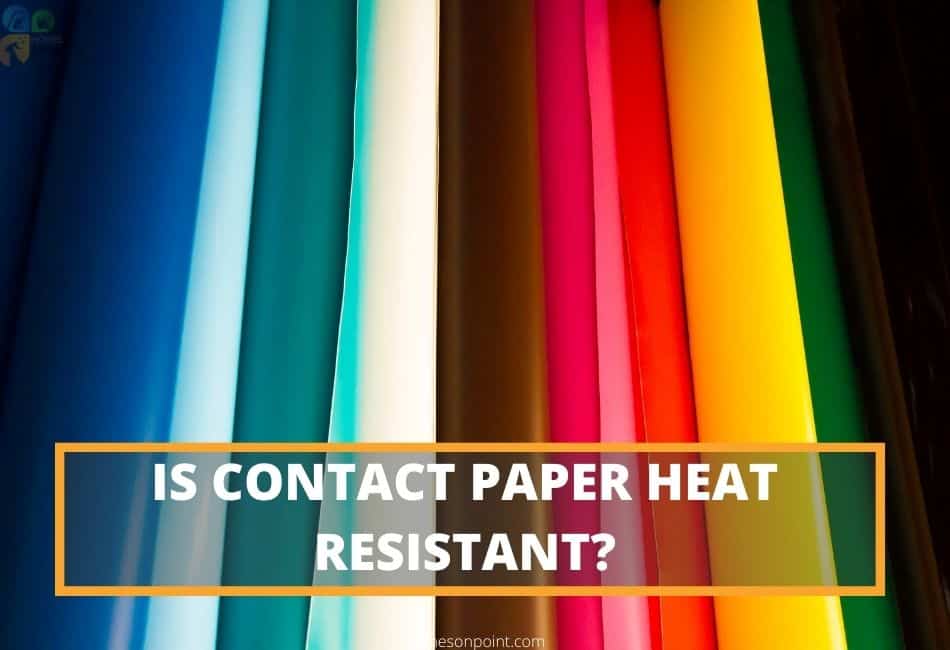There are a lot of myths and misconceptions about contact paper out there. Some people think that contact paper is heat resistant, while others believe that it is not. So, what is the truth? Is contact paper heat resistant or not?
Contact paper can resist heat to some extent. However, it is not completely heat resistant. If you put contact paper on a hot surface, it will start to melt and deform. The adhesive backing will also begin to break down, causing the contact paper to lose its stickiness. Some are more heat resistant than others, but it is generally not good to expose contact paper to heat.
To better understand why contact paper is not a very good heat conductor, it is important to know what contact paper is made of.
What Is Contact Paper?
Contact paper, also known as peel-and-stick wallpaper, is a type of adhesive paper that is used to line shelves and drawers, cover countertops, and much more. It is made from vinyl or PVC and has an adhesive backing. The adhesive allows the contact paper to stick to surfaces without the need for nails, screws, or tape.
Contact paper is made by combining two layers of material with an adhesive in between. The top layer is usually a clear film or paper that has been printed with a design. The bottom layer is made of vinyl or PVC.
Contact paper is usually sold in rolls or sheets. It is available in a variety of colors, designs, and textures. You can even find contact paper that looks like wood or marble.
What Are the Different Types of Contact Paper?
There are two main types of contact paper: self-adhesive and heat-activated.
Self-adhesive contact paper has an adhesive backing that allows it to stick to surfaces without the need for nails, screws, or tape. This type of contact paper is easy to use and can be removed without damaging the surface.
Heat-activated contact paper has a special adhesive that is activated by heat. This type of contact paper is more difficult to use, but it will create a stronger bond.
How to Determine if Contact Paper Is Heat Resistant
There are a few ways to determine the extent to which contact paper is heat resistant.
1. Check the packaging
Most contact paper manufacturers will list the product’s heat resistance on the packaging. This is not difficult to find and can give you a good idea of how heat-resistant the contact paper is.
2. Check for a label
Some contact paper products have a “heat resistant” label. This label is usually located on the back of the contact paper roll or sheet.
If there is no label, you can assume that the contact paper is not heat resistant. It is better to err on the side of caution and assume that the contact paper is not heat resistant if there is no label.
It is worth noting that some contact paper packaging or label will display heat resistant contact paper but fails to disclose the level of heat resistance. If there is no label or the packaging does not list the contact paper’s heat resistance, the third point will help
3. Do a test
To get an accurate idea of the contact paper’s heat resistance, it is best to test it yourself. Place a small piece of contact paper on a hot surface. If it starts to melt or deform, it is not heat resistant. You can test it with varying levels of heat to see at what temperature the contact paper begins to melt.
Keep in mind that the contact paper’s heat resistance may be different than the adhesive’s heat resistance. Adhesives are usually more heat-resistant than contact paper. This means that the contact paper may start to deform at lower temperatures than the adhesive.
Levels Of Heat Resistance In Contact Paper
The level of heat resistance will vary depending on the type of contact paper. For example, self-adhesive contact paper generally has a low level of heat resistance, while heat-activated contact paper usually has a high level of heat resistance. There are three levels of heat resistance in contact paper:
- Low heat resistance: Contact paper can resist heat up to 120 degrees Fahrenheit
- Medium heat resistance: Contact paper can resist heat up to 150 degrees Fahrenheit
- High heat resistance: Contact paper can resist heat up to 200 degrees Fahrenheit
It is important to note that the contact paper’s heat resistance will decrease over time. This means that contact paper that is heat resistant today may not be heat resistant tomorrow.
Why Contact Paper Not CompletelyHeat Resistant?
Contact paper is not heat resistant because it is made of vinyl or PVC. These materials can start to break down at high temperatures. They are not as heat resistant as other materials like ceramic or metal.
Vinyl is a type of plastic that is made from ethylene and chlorine. These are made up of molecules that are held together by weak bonds. When exposed to heat, these bonds can start to break down. This process is called thermal degradation. This is why contact paper can become sticky or gummy when it gets too hot.
PVC is a type of vinyl that is made from petroleum. It is a cheaper alternative to rubber. PVC can also be used to make contact paper. It is not as heat resistant as vinyl, but it is more heat resistant than other plastics. PVC starts to break down at about 176 degrees Fahrenheit.
How To Protect Contact Paper From Heat Damage
If you must use contact paper in a high heat area, there are some things you can do to prevent heat damage and prolong its life. Just like countertops, you can use heat-resistant protectors to prevent heat damage. Here are some things you can do;
1. Use trivets to protect contact paper from direct heat.
A trivet is a type of pad that is used to protect surfaces from heat. They are usually made of metal or ceramic. You can place a trivet between the contact paper and the hot surface to protect it from direct heat.
2. Use hot pads to protect contact paper from direct heat.
Hot pads are similar to trivets but they are usually made of heat-resistant materials like silicone. They can be used to protect contact paper from indirect heat, like steam or hot water.
3. Use cutting boards to protect contact paper
Though not its primary purpose, you can use a cutting board as a barrier between your contact paper and direct heat. This will protect your contact paper from melting or sticking to the surface.
Final Thoughts
Now that you know the answer to “is contact paper heat resistant?”, you can use it with confidence in your home. Just remember to take some precautions if you are using it in a high-heat area. With a little care, your contact paper will last for an extended period of time. So, while contact paper is not heat resistant, it is still a good choice for many projects.
FAQs
Q: Does contact paper melt?
A: Contact paper can start to melt at high temperatures. This is because it is made of vinyl or PVC, which are not as heat resistant as other materials. At high temperatures, it will start getting soft and sticky.
Q: What is the highest temperature contact paper can withstand?
A: The level of heat resistance will vary depending on the type of contact paper. For example, self-adhesive contact paper generally has a low level of heat resistance, while heat-activated contact paper usually has a high level of heat resistance.
Q: Do you need to seal contact paper countertops?
A: Yes, you should always seal contact paper countertops. This will protect them from heat, water, and stains.
Q: Can contact paper go in the oven?
A: No, contact paper should not go in the oven. The high heat can cause it to melt or catch on fire.
Q: Can contact paper go in the microwave?
A: No, contact paper should not go in the microwave. The high heat can cause it to melt or catch on fire.

